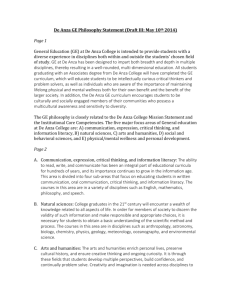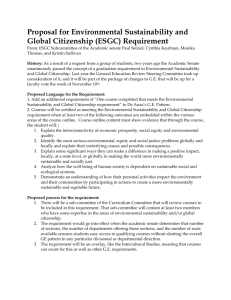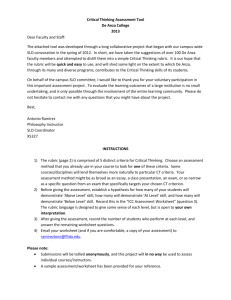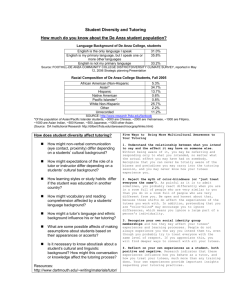De Anza College Case Study - Santa Barbara City College
advertisement
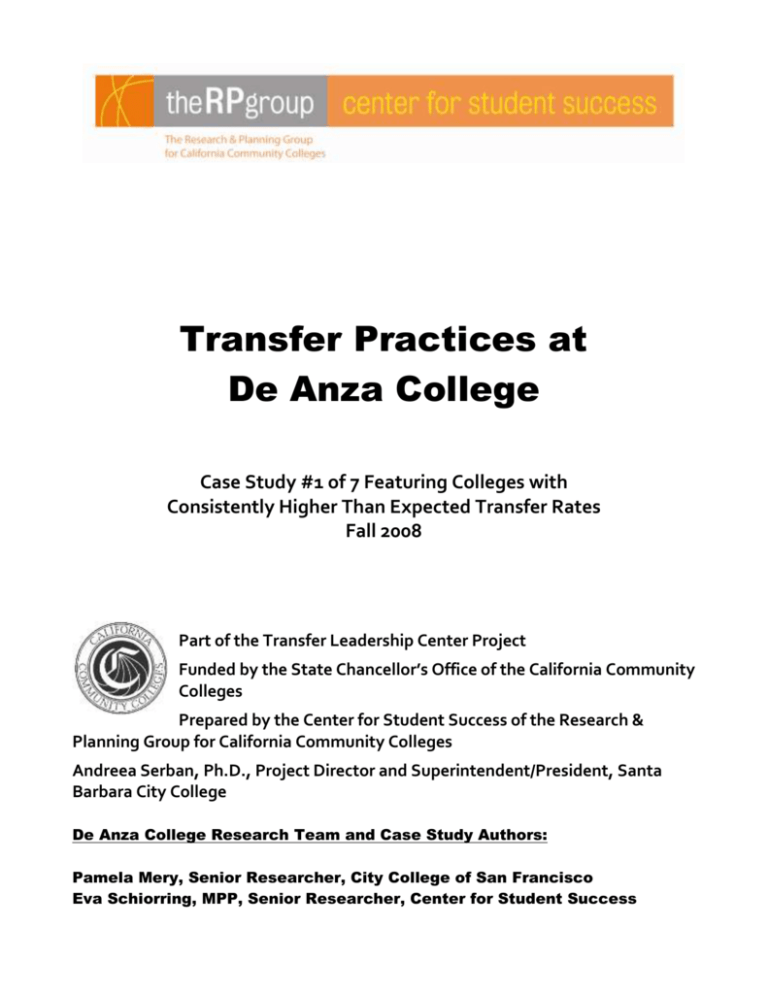
Transfer Practices at De Anza College Case Study #1 of 7 Featuring Colleges with Consistently Higher Than Expected Transfer Rates Fall 2008 Part of the Transfer Leadership Center Project Funded by the State Chancellor’s Office of the California Community Colleges Prepared by the Center for Student Success of the Research & Planning Group for California Community Colleges Andreea Serban, Ph.D., Project Director and Superintendent/President, Santa Barbara City College De Anza College Research Team and Case Study Authors: Pamela Mery, Senior Researcher, City College of San Francisco Eva Schiorring, MPP, Senior Researcher, Center for Student Success Abstract: This report is one in a series of seven case studies of California community colleges with higher-than-expected transfer rates. Each case study is based on a site visit conducted in Spring 2008 by two Center for Student Success researchers to document and investigate the full spectrum of factors, inventions, strategies and practices that each college is implementing to support transfer. The case studies are part of the Transfer Leadership Center (TLC), the most comprehensive study to date of two-to-four-year transfer in California. The California Community College State Chancellor’s Office awarded the TLC in Spring 2007, based on a competitive grant competition and grant written by Dr. Andreea Serban, Superintendent/President, Santa Barbara City College. The project has been implemented by the Chancellor’s Office of the California Community Colleges (CCC), the Center for Student Success (CSS) of the Research and Planning Group of the CCC, and California Partnership for Achieving Student Success (Cal-Pass). The study is administered by the Santa Barbara City College and guided by an Advisory Committee including leading experts on transfer. Readers of the case study presented here may also be interested in the following, which are available on-line at http://www.sbcc.edu/tlc TLC Literature Review TLC Cross-Case Analysis (an analysis of all seven colleges in the study) TLC Case Study #1: De Anza College TLC Case Study #2: Irvine Valley College TLC Case Study #3: Los Angeles Southwest College TLC Case Study #4: Porterville College TLC Case Study #5: Reedley College TLC Case Study #6: San Diego City College TLC Case Study #7: Skyline College For questions about any of these research papers, please contact Dr. Andreea Serban at Serban@sbcc.edu -2- DE ANZA COLLEGE TRANSFER PRACTICES AND STRATEGIES CASE STUDY Introduction: In Spring 2007, the State Chancellor’s Office of the California Community Colleges awarded the Transfer Leadership Center (TLC) study to investigate two-to-four year transfer practices and strategies. As part of the study’s qualitative component, research teams from the Center for Student Success of the Research & Planning Group of the California Community Colleges conducted site visits to seven community colleges with higher-than-expected transfer rates. The site visits included extensive interviews and focus groups conducted with students, college counselors, faculty, administrators, classified staff, representatives from special programs, and high school counselors. It should be emphasized that the research focused exclusively on what each of the seven colleges are doing to support and increase two-to-four year transfer. Accordingly, the case study that follows should be read not as an assessment of the featured college’s overall performance, but rather as a review and analysis of one particular area of operations. Moreover, the case studies focus on what appeared to the researchers to be the most salient elements of the colleges’ efforts to encourage and support transfer. The case studies are therefore not intended to present an exhaustive list of all transfer-related initiatives and practices at each college. In addition to case studies on each of the seven colleges, the research team developed a cross-case analysis to identify common factors which appear to contribute to higher-than-expected transfer rates. The cross-case analysis – as well as the research protocols and the literature review upon which the protocols were based – can be found at http://www.sbcc.edu/tlc Acknowledgement: The Research Team wishes to thank the many students, staff, faculty, and administrators at De Anza College who contributed to the research. We greatly value the perspectives you shared with us and the experiences and insights you provided. A special thank you goes to Tina Woo, Special Assistant to President Murphy, for her invaluable assistance coordinating interviews and focus groups before and during the visit. Thank you also to Transfer Center Coordinator, Shirley Kawazoe, for the time she so generously spent with the Research Team. -3- CASE STUDY: DE ANZA COLLEGE De Anza College President: Dr. Brian Murphy San Francisco Bay Region: Cupertino, CA Fall 2007 Enrollment: 24,967 Ethnicity 36% - Asian/Pacific Islander 25% - White 17% - Hispanic 6% - African American 5% - Filipino 11% - Other Gender 51% - Female 49% - Male Age 33% - 19 and younger 30% - 20 to 24 12% - 25 to 29 6% - 30 to 34 18% - 35 and older Faculty 311 Full-Time and 293 Part-Time Counselors 27.2 FTEs, including categorical counselors SUMMARY “If my students transfer to UC, their skills will be at the level required to succeed.....we are a college that prepares its students.” – De Anza Faculty, February 2008 “From the moment I stepped in it was all about transfer.” – De Anza Student, February 2008 De Anza College has the inherent advantage of being located on a large, university-like campus in the heart of prosperous Silicon Valley. However, while De Anza’s physical attributes are clearly a draw for students with transfer aspirations, the research team identified other, more replicable factors at work that contribute to the college’s higher-than-expected transfer rate. These include De Anza’s strategic and deliberate approach to institutional development, its encouragement and support of academic excellence and achievement, its tradition of innovation, and its experimentation with ways that integrate student services with instruction. The research team also found general agreement among informants that De Anza College’s current transfer priority is to parlay the success it has achieved serving well-prepared students into transfer success for underrepresented populations. The college is pursuing this objective in the systematic and deliberate fashion that seems to be its trademark. -4- De Anza’s capacity to deliver excellent education was identified by many informants as a characteristic that inspires students and prepares them for transfer. In particular, students expressed confidence that De Anza prepares them for success at the university level. Factors contributing to the college’s success in recruiting and retaining talented and committed faculty members include relatively high salaries, a stimulating academic environment that embraces diversity, and active encouragement of innovation that increases student success. The message of transfer, according to informants, is emphasized everywhere: in the targeted outreach to high school students and their parents; in the orientation and college success course; in informational and promotional materials; in the classroom; in messages delivered by top administrators; in annual events; and in the constant presence on campus of representatives from four-year colleges. The infrastructure that directly supports transfer includes a well-funded articulation office, an effective transfer center that focuses on underserved students, and counseling services that many described as over-extended. When asked what they would do if they had additional resources to invest to support transfer, several informants responded they would hire more counselors and deploy them in ways that strengthen the linkage between instruction and counseling. The findings made during the site visit are consistent with a profile of De Anza College developed as part of “The Study of Good Work in Higher Education,” i a study of 10 institutions identified as “outstanding providers of undergraduate education.” ii This study identified two key factors that contribute to De Anza students’ success: “(1) exceptional professionals that are dedicated to student achievement and (2) an excellent quality of education that is affordable and convenient for students.” Factors and Indicators Contributing to Higher-Than-Expected Transfer Rates at De Anza College FACTORS Institutional emphasis on academic achievement and advancement Dynamic environment that encourages experimentation and innovation Deliberate and strategic approach to institutional development INDICATORS Job openings draw a large pool of applicants creating opportunities to hire “top notch” faculty and staff who want to “contribute inside and outside of classroom” Faculty takes pride in the fact that they “maintain high academic standards that prepare students for transfer” Expansive list of course offerings Use of role models – faculty, graduates, peers Faculty and staff collaborate within their own divisions to design and experiment with new ways to increase retention Innovation rewarded with significant monetary incentive and with recognition Campus-wide initiative to recruit, retain and transfer underrepresented student populations Strategic recruitment and hiring of faculty and counselors that look like and can relate to the students; 70% of new hires are non-white and/or female; 80% of faculty are bilingual Use of data to drive and shape institutional priorities and initiatives -5- Transfer culture Transfer support and services Strategic relationship with local high schools Strong relationship with four-year universities Effective use of technology High level of commitment to institution Communication to students of high expectations Transfer message: De Anza is a stepping stone Expectations presented on a continuous basis and from multiple sources: counselors, faculty, peers, graduates Physical environment conveys impression that this is a university campus Transfer Center targets most of its resources to serve underrepresented populations Articulation function has staff of three, including one newly re-designed position that focuses on articulation Articulation Officer trains faculty to develop curriculum that can be articulated with four year-colleges Strong financial aid function that participates in outreach 12-hour Student Success Course focuses on transfer Opportunities and reasons for transfer are major themes in Orientation Guide Systematic, deliberate outreach Selected high schools targeted for special outreach by programs serving underrepresented populations Continuous presence of four-year colleges on campus Annual Transfer Day attracts dozens of four-year colleges and universities Wealth of updated articulation information easily available on intranet for faculty and staff Well-organized web resources available for students Low turn over among leadership (three presidents since inception in 1967), faculty, counselors and classified staff Widespread consensus about mission and purpose Widespread commitment to students, community Pride in institution among students, faculty, administrators, and staff -6- 1. METHODOLOGY The site visit was conducted February 27 and 28, 2008. It included 11 interviews and seven focus groups with a total of 42 participants (see Appendix 1). In preparation for the site visit, the research team reviewed the most recent self-study, the 2007-2008 catalog, the Spring 2008 Schedule of Classes, and documents available on De Anza’s extensive website explaining the college’s transfer services, student services programs, articulation agreements and strategic planning priorities. During the site visit, additional documents were obtained, including student guides to De Anza, the 2007-08 Orientation Guide and statistical information related to transfer. Appendix 2 lists documents reviewed for the study. 2. COLLEGE OVERVIEW 2a. College Profile College History and Community: De Anza College is located on a 112-acre campus in the heart of Silicon Valley. The college, as noted by many informants, has the feel of a university campus with its low, well-constructed buildings and state-of-the-art centers and facilities, including the newly constructed Student and Community Services Building, the Kirsch Center for Environmental Studies, and the Flint Center for the Performing Arts. One of two colleges in the Foothill-De Anza Community College District, De Anza opened in 1967. With an average fall enrollment of 25,000 students, it is one of the largest, single-campus community colleges in the country. The college operates on a quarter system. Student Profile: De Anza serves a diverse student population. In Fall 2007, the largest student group by ethnicity was Asian (36%); White students represented 25%; and Hispanic / Latino students 17%--up from 10% five years earlier in Fall 2002. One-third of the students are 19 years old or younger. 63% are 24 or younger. Several informants, including the College President, described two different student populations that De Anza is serving. One is the traditional, well-prepared student who is expected to succeed. The other is the type of student De Anza is targeting through special outreach, recruitment, retention and transfer services. These students are from traditionally underserved populations and are less wellprepared than the traditional De Anza transfer population. Mission Statement: De Anza’s mission statement declares that: “Building on its tradition of excellence, De Anza College challenges students of every background to: develop their intellect, character and abilities; achieve their educational goals; and, serve their community in a diverse and changing world.” In interviews, informants highlighted the first and second objectives as they referred to De Anza’s reputation for academic excellence and transfer success. The commitment to serve the community was expressed mostly in terms of how the college itself is working systematically to recruit, retain and transfer students from underserved populations. The President also emphasized De Anza’s commitment to “not just educate, but empower students. “ This mission was probably best exemplified in how the college systematically recruits traditionally underserved students and provides them with access, not merely to academic opportunities, but also to programs that help them recognize their own potential. -7- “In the San Jose State University assessment test for accounting students, our transfer students always do better than...[the native] students.” – Faculty Member “The college wants you to come in with a spirit of innovation because it is good for the students.” – Faculty Member “There is always something transfer related going on.” – Student “Transferring is a learned activity – having a culturally competent staff of people who understand this is a key to success.” – Transfer Counselor “Transfer is not just a student service; it is a campus-wide endeavor.” – College President “You cannot work here if you expect to work 30 hours a week. We do 50-60 hours a week.” – Faculty Member “We look not just for the best teachers, but for the best teachers who will get involved.” – College President 2b. Transfer Profile Transfer Indicators: The 1998-99 through 2000-01 cohorts that were tracked for the purpose of the transfer study (see Appendix 4) ranged in size from 2,486 to 2,624 full-time, first-time De Anza students. The actual transfer rate for these cohorts remained stable at around 58. The actual lessthan-expected transfer rate remained around seven.1 Statistical information provided by the college showed a slight (2%) increase in transfers to UC and CSU campuses between 2004-2005 and 20052006. The Accreditation Self-study states that “De Anza ranked number one in combined CSU and UC transfers in 2002-03,” and that “the college has maintained this ranking for the majority of the last 10 years.”iii De Anza shared with the researchers a study conducted in 2005 of transfer rates achieved by different ethnic groups from among the college’s Fall 2001 cohort. The finding indicated that of De Anza students, Asian students had the highest rate of transfer success, followed by White students. African American and Latino/Hispanic transferred at approximately half the rate of Asian students. In addition to the information it provided on success rates by ethnicity, the study exemplifies De Anza’s continuous tracking of student outcomes. When the Research Team requested additional information on student achievement, a series of statistical studies were readily provided by the College’s Office of Institutional Research and Planning. The President also emphasized the key role research plays in informed decision-making at the College. Transfer Center, Articulation and Counseling Staff: De Anza’s interpretation of Title 5 guides the Transfer Center’s mission, which is to serve students from groups that have traditionally been underrepresented among the college’s transfer population. Students who are not from these groups and who need standard transfer counseling services are The transfer rates used for this study were drawn from the 2005-06 Report, which contained the most up-to-date data available. Subsequent editions of the Transfer Rate Report (due out late in fall 2008) will include more recent cohort years (and drop the oldest cohort years); also, the rates themselves will be somewhat - although in most cases not markedly - different. To better understand how the rates may change, please see Appendix 4. 1 -8- primarily served by the college’s 30 general counselors. In a focus group, representatives from this group described their large caseload and expressed regret that “we are too rushed” and “[we] spend too much time as academic advisors and not enough as counselors.” The Transfer Center shares a space with the student support program, Student Success and Retention Services Center (SSRSC), a project that provides academic advising, mentoring, leadership development and study groups to underrepresented and first-generation students. SSRSC serves 500-800 students a year, including many students who also participate in other student success programs such as Puente and the Math Performance Success Project. In a focus group that included eight SSRSC participants, students said they “don’t really distinguish between the Transfer Center and SSRSC.” De Anza’s Articulation Office has a staff of three: the Articulation Officer, an Articulation Specialist and an administrative assistant. The Articulation Specialist, the Articulation Officer explained, is a newly re-designed position. The Articulation Officer noted that De Anza has invested considerable resources in the articulation function and that, by comparison, not many of her colleagues around the state have staff. She added that she also has a small budget to promote articulation. 2c. Transfer-Related Investments Some transfer-related investments were initially covered by grant funds but have since been assumed by general funds. These include an SSRSC transfer counselor who was initially supported by Partnership for Excellence (PFE) funds. The college has also invested in new transfer-related positions, including the Articulation Specialist. The general counselors explained that they were allocated PFE funds to hire additional counselors. This increased counseling hours available to students and improved opportunities for counselors to meet, participate in training, and communicate with faculty. 2d. The Student Transfer Experience To assist the reader in “seeing De Anza College through students’ eyes,” the researchers created two student profiles. Luong is a composite of the more traditional De Anza students. Lucinda exemplifies the less transfer-directed students the college is committed to recruiting and serving. The information that shaped the two stories came from interviews and focus groups with students, counselors, faculty advisors, high school counselors and representatives from academic support programs. Composite Case Studies: Luong’s Student Transfer Experience: Luong drives to De Anza College four days a week. It is a long commute from East San Jose, and one that takes Luong past several other community colleges. But Luong knew all along that he wanted to go to De Anza after high school. Many of Luong’s friends made the same choice. They talked about it before applying and were a bit worried because De Anza has a reputation for being very demanding. But De Anza, Luong believes, is the best place to go for somebody who, like himself, wants to transfer to UC. It is, as his friends and high school teachers say, a transfer school. Luong’s parents think De Anza is a good choice as well. They decided this after attending De Anza’s Parents’ Night Event. Luong’s impression that De Anza is a transfer school has been reinforced since he enrolled. There is always something transfer-related going on at the campus. This is the case in the classroom as well. Almost all Luong’s instructors talk about transfer and assure the students that the bar is set very high to ensure that they are transfer ready. Luong checks in with a counselor every quarter to make sure he is taking all the classes he needs to transfer. The counselor is really good, but doesn’t have much time to answer Luong’s questions. The area outside is packed with other students waiting to see a counselor. Luong leaves with an updated education plan. As he had begun to suspect, he will need to spend almost three years at De Anza before he is ready to transfer as an engineering major at a UC. -9- Lucinda’s Student Transfer Experience: Lucinda wasn’t planning to go to college until a De Anza outreach person came to her high school to talk about college. The outreach person impressed Lucinda right away because she spoke Spanish fluently and talked about her own experience. From her, Lucinda learned about all the different academic programs De Anza offers. Even more importantly, she met a De Anza student mentor from the college’s SSRSC program who told her about all the help she would be able to access at the college. Lucinda then brought her parents to an event sponsored by De Anza for parents of Latino students. In the past, her parents had not thought Lucinda would be the first member of the family to go to college. This changed when her parents had a chance to see the college and meet with a financial aid officer who was part of the campus tour. Lucinda’s transition into the college was facilitated by assistance she received from Puente and SRSSC. Through these groups, she started to feel that she belongs on the campus and that there are people who can help her with anything from updating her education plan to deciding whether she needs to cut down on the number of hours she works every week. The Transfer Counselor was also ready when she told him she failed the first major Basic Skills math test. He referred her to the Math Performance Success project and with the help of a tutor she has begun to realize that she actually may not be so bad in math. This is great news since her SSRSC counselor has made her start thinking about transferring to UC Davis where she would like to major in Environmental Studies. Lucinda met a representative from UC Davis who is on campus a lot, and he told her about all the opportunities she would have with a BA in Environmental Studies. 3. COLLEGE CULTURE In 2003, De Anza College was one of 10 educational institutions nationwide included in a study of “good work in higher education.” (Berg, 2003). The best-practices study identified as major factors contributing to De Anza’s success the college’s “exceptional faculty and staff” and its ability to offer “excellent quality that is affordable and convenient.” The two-day research visit, although maintaining a narrower focus on factors contributing to success in transfer, made similar findings. “We are fortunate to receive many applications for each job opening,” the College President explained, “so we have a top-notch faculty. In hiring, we look not only for the best instructor, but for the best instructor who will get involved in campus life.” Another hiring priority is to recruit faculty and staff who look like the students they serve now and will serve in the future. “For many years, about 70% of our new hires have been non-white and/or female. About 80% of our faculty also speak a language other than English.” (College President) The culture of innovation may be one factor that attracts talented faculty members to De Anza. The basic principle is that those who are closest to the students should be encouraged to use their insights and expertise to drive innovations that have potential to improve student outcomes. The research team heard at least two specific ways in which this principle is advanced. One is strategically in the reliance on faculty-staff teams to use their expertise to translate the campus-wide goal of retention into an action plan for their own division. The other is expressed in terms of recognition and monetary awards granted each year to faculty who have innovated in ways that support student learning and achievement. Another De Anza characteristic mentioned frequently during the site visit is the college’s use of the quarter system. While it is outside of the scope of this study to speculate whether the intensity of the academic session has an impact on increasing student success and transfer, the researchers heard students praise the quarter system because it is “short and keeps my attention,” “means you don’t have to wait long to take a class over when you fail,” and “allows you to take lots of classes.” -10- 3a. Messages and Information About Transfer Click on “about De Anza” on De Anza’s home web page and the first question posed is “Why De Anza?” The number one reason, the website responds, is the college’s “Exceptional Transfer Rate.” Click again to learn that “De Anza consistently ranks #1 or #2 in the state for the total number of students who annually transfer to UC and CSU campuses.” The message that De Anza is one of the top transfer schools in the state was repeated in interviews with administrators, faculty, staff and students, often with a note of pride. “Students from the East Side (of San Jose) come here because they want to transfer.” (Faculty focus group) It was also identified by high school counselors who “push the message” because “we know [De Anza] is a good institution and that some students have a better chance of getting into UC if they come here than they would if they try [to transfer to a UC] as freshmen.” (High school counselor) In fact, De Anza’s transfer identity, combined with the college’s reputation for academic excellence and rigor, sometimes discourages students who feel “they are not ready for De Anza” (Faculty focus group). The college has countered this impression through a carefully choreographed outreach effort directed at potential and actual feeder high schools. Once students enroll at De Anza the transfer message surrounds them. The opportunity of and rationale for transfer are both key themes in the college’s Orientation Guide which graphically relates educational attainment to earnings potential, identifies different types of transfer institutions, and introduces a wealth of how-to information about choosing courses for transfer. The transfer theme is also a central feature of the college’s one-unit Counseling 100: Orientation to College course (discussed in section 4e). Further, it extends into the classroom, where instructors inform students that courses are taught at a level that will prepare them for transfer and into office hours where many faculty members talk with students about educational and career opportunities in their field. Transfer is also one of the main goals presented to participants in SSRSC, EOPS, Puente and other support programs. These students, while receiving a full range of academic and support services from these programs, are also – because they are underrepresented among transfer students – first in line to be served by the Transfer Center (see below). 3b. Transfer Goals and Plans The College President distinguished between the “primitive” way to express De Anza’s transfer goal – which is to continuously increase transfer rates – and the commitment to increase the transfer rate for special populations that is an extension of the college’s strategic plan and priorities. “We want to take the cachet the college has earned by transferring students who are expected to achieve and parlay it into success for students who have not succeeded historically,” the President explained. De Anza is characteristically approaching this expanded transfer goal in a deliberate and strategic manner. It has expanded its capacity to conduct recruitment at an increasing number of high schools, including those serving the region’s rapidly growing Latino/Hispanic youth. Once students enter the college, those placing into basic skills English or Math will be able to take advantage of the college’s Basic Skills Initiative, which supplements each developmental course with a one-unit tutorial. In addition, students can attend the Math Performance Success Program. A recent initiative includes the development of division-based retention teams that will identify, diagnose and respond to students experiencing academic difficulties before these efforts turn into failures. Retention teams will include both instructional and counseling staff. In this sense, they are a continuation of De Anza’s experimentation with how to most effectively integrate instruction and student services. The retention initiative will be supplemented by an Early Alert Computerized Program System through which faculty work with counselors to respond to students who are showing signs of academic difficulty. -11- 3c. Communication and Collaboration Among Individuals who Run Programs and Services that Promote and Support Transfer Counselors meet on a regular basis. During the first part of the meeting everybody is together. During the second part of the meeting participants divide into groups according to specialty area. The general counseling staff explained that the counselors used to meet more frequently when they had part-time counselors who could keep the counseling component operating while the full-time counselors met. Now, by contrast, services have to be curtailed during meetings. Students are often referred from one counseling service to another. The Transfer Center counselor explained that she will most often refer students who are not from underserved populations and who need standard transfer counseling services to the general counselors. General counselors, in turn, refer students who can benefit from more comprehensive counseling and who are from underserved populations to the Transfer Center. The general counselors are concerned that this system can be confusing for students. Communication and collaboration between counselors and faculty have changed over time and were changing again at the time of the site visit when, as part of the strategic planning initiative, divisions are forming retention teams that include specially assigned counselors. Several informants commented that the new philosophy is that transfer is not just the responsibility of student services but rather a campus-wide endeavor which, to be successful for all student populations, requires the participation of instruction, student services and administration. This shift in perspective gained momentum when projects designed to improve opportunities for underrepresented populations created opportunities for counselors to work closely with faculty members. The Articulation Officer is also involved in providing transfer-related services beyond typical articulation functions. The Articulation Officer’s second title is “Transfer Services Coordinator,” and her office is a major intersection connecting faculty with transfer information and training. “I meet with faculty one-on-one and I also conduct workshops for faculty initiators [of curriculum that may be articulated with four-year institutions], the Articulation Officer explained. The Articulation Officer explained that she works most closely with the Transfer Center Coordinator who alerts her to problems she sees with students “whether they (the problems) are internal or inter-segmental.” 4. SERVICES AND PROGRAMS SUPPORTING TRANSFER 4a. Scope and Quality of Transfer Centers and Other Transfer Support Services At De Anza, the Transfer Center’s main mission is to encourage and improve transfer for underserved populations. In this sense, De Anza interprets Title 5 of the California Education Code literally, as a mandate to target transfer support services to particular groups of students. Correspondingly, the Transfer Center allocates most of its resources to underserved populations. “I’d say we dedicate 75% of our time and resources to them [underserved populations] and 25% to regular students,” a Transfer Center informant assessed. “We’d like to get to a point where all our efforts are directed at serving underserved populations who normally don’t transfer,” she added. “That way we’d get back to the original interpretation of Title 5.” The Transfer Center employs a Transfer Coordinator, a Transfer Counselor, two Academic Advisors, and an Administrative Assistant who work with five SSRS peer advisors who are students from underserved populations and who are well on their way to transferring. “The best people to promote transfer are students transferring themselves,” a Transfer Center informant noted. In a student focus group, several of the participating peer counselors commented that “we have to do well, because we are role models now for others.” -12- 4b. Role and Scope of Counseling and Dissemination of Transfer Information All students have access to a wealth of transfer information provided online, through college publications, and conveyed in presentations and speeches. As an example, the college has developed Transfer Publications for Students and TAA/TAG Information Handouts. Students also have access to representatives from four-year colleges who regularly and frequently visit the campus. In addition, students are assisted by “‘mini-assessment” or “triage” services provided at the beginning of each quarter by the Transfer Center Counselors. In addition to getting students off to a good start, triage serves as a major recruitment ground for SSRS students. “This is a great opportunity for us to make contact with students from underrepresented groups. We give them a card and ask them to schedule an appointment with us [the Transfer Center] the following week.” Students served by the Transfer Center often participate in several support programs such as SSRSC and Puente. This way, these students have access to a more comprehensive range of academic and other support services than their peers. As an example, students served by the Transfer Center explained that they can drop in whenever they have a question and receive help without having to schedule a formal appointment. Students using general counseling services, by contrast, have short appointments and often have to wait both to schedule the appointment and to actually see the counselor. 4c. Scope, Quality and Use of Articulation Agreements The most recent Accreditation Self-study from 2005 stated that De Anza participates in a regional GE reciprocity agreements with six other community colleges and has articulation agreements with 17 CSU campuses, 9 UC campuses and 26 private and/or out-of-state four-year institutions.iv The Articulation Officer identified Business Administration (transferring to San Jose State University) and science-related programs (transferring to UC Davis) as the most common transfers. The college’s transfer priority, the Articulation Officer said, is to “make sure students are transfer ready and that they have the resources they need to take advantage of opportunities to transfer.” A main focus of her job is to prepare courses for transfer and communicate with the four-year colleges and universities to develop transfer admissions agreements and guarantees. She also works closely with the Transfer Center Coordinator to address internal and inter-segmental problems that arise for transfer students. To facilitate the development of effective articulation agreements, the Articulation Officer works closely with faculty and sits on the curriculum committee. “The College really supports my position,” she observed and “is very receptive to my input and suggestions.” To increase faculty’s capacity to develop curriculum that articulates to four-year institutions, the Articulation Officer hosts monthly 90minute workshops for faculty initiators (“Workshops/Training – Articulation Overview for Curriculum Writers”), meets with them individually, and reports to divisions on the status of articulation initiatives and requirements. One of the Articulation Officer’s objectives is to encourage faculty to meet with her during the planning phase of the curriculum development process: “The earlier they [the faculty] come before creating curriculum, the better they (the courses) can articulate,” she explained. The Articulation Office uses technology to increase the effectiveness of its communication with faculty and to provide individual faculty members with updated information about articulation requirements and with access to tools they can use to guide their curriculum design. “Normally, you’d have the transfer policies in binders, but since 2001-2002 we have put them on the intranet site,” the Articulation Officer explained. The intranet site also provides a wealth of other information that is designed to increase faculty’s awareness and understanding of transfer. The well-organized website includes “announcements and -13- events” with updates on articulation guidelines such as CSUGE/IGETC; “transfer information” including a transfer resource guide, student handouts, and updates on legislation and statewide issues; “articulation information” identifying agreements in place with public and private colleges and transfer admission agreement/guarantees in place with CSUs, UCs and private institutions. A second intranet site offers extensive resources for counselors and academic advisors. It is updated and maintained by the articulation specialist whose duties also include the preparation of publications and outreach materials for targeted high schools. 4d. Availability of Financial Aid and Scholarship Information The Financial Aid Office works closely with the Transfer Center and with the general counselors to enroll students early on, preferably before the first day of classes. Accordingly, Financial Aid participates in outreach activities to high schools and is represented at events such as Parents’ Night. Once students have applied for financial aid, the goal is to help them maintain their support. To do so, the Financial Aid Office electronically alerts students to deadlines they cannot miss and informs them of scholarships they might consider pursuing. The Financial Aid Officer noted that it is acceptable and sometimes wise to limit new students’ education plans to one or two quarters so they don’t become overwhelmed. At the other end of the spectrum, where students are exceeding the unit limitation for financial aid because they started out in developmental courses or changed direction along the way, the college is generous. “We almost always extend the financial aid limitation,” the Financial Aid Officer explained. “At that point, though, you need to follow an education plan to the script.” Other informants working directly with students spoke highly of the Financial Aid Office’s willingness to be a team player – adding resources to high school outreach activities, for example. 4e. Special Services and Programs Supporting Transfer, Including Academic Support Services Education Plan Triage: The beginning-of-quarter education plan triage previously described provides students with additional opportunities to access counselors. During the triage period Transfer Center counselors conduct mini-assessments that get students off to a good start. The triage period connects students with counselors and, the college believes, increases the probability that students will continue to work with a counselor. College Success Course: Counseling 100 is a required 12-hour orientation course for new students. It is offered in different formats and at different times to allow every student the opportunity to enroll. The course is also available online. The purpose of Counseling 100 is to provide students with “an overview of programs, services, policies, degree, certificates, transfer requirements and college culture.” The course objectives include a review of majors which transfer, introduction to transfer information and articulation agreements, examination of general education patterns, and completion of a one-quarter student education plan. The counselors who teach the course explained that they know the course overloads students with information and that one of the most important goals is to persuade students that they should schedule an appointment with a counselor. “Come by for counseling....that is what we want students to remember,” one counselor explained. Orientation Guide: The College publishes a comprehensive Orientation Guide that students receive at Orientation. The booklet’s focus is on transfer – the opportunities having a BA provides, the economic impetus for getting one, the how-to of transfer, and information about baccalaureate institutions in California. Writing and Reading Center: This drop-in tutoring and workshop program was mentioned by several informants as a resource that students use to develop effective personal statements for transfer. -14- 5. TRANSFER OF SPECIAL STUDENT POPULATIONS The college has two programs for special student populations that identify transfer success as a key activity and objective: the Student Success and Retention Services Center (SSRSC) and Puente. Puente is designed to increase transfer for educationally underserved students, particularly those of Hispanic/Latino origin. It is an intense program offered to a limited number of participants and provides a wide range of academic and support services. SSRSC is described as “a supportive community of peer mentors, tutors, faculty, and staff and assists students with defining and successfully achieving their educational goals.” The program offers services ranging from academic mentoring to leadership development, education planning and personal counseling. The program targets first-generation college students and students with historically low rates of student success. SSRSC emerged when two programs, Student Leadership Academic Mentoring for Success (SLAMS) and Student Transfer Academic and Retention Services (STARS), were consolidated. Students in the SSRSC and Puente support programs are constantly reminded of the opportunity of transfer. “Puente puts it [transfer] out there every day,” one student commented. Transfer counseling is provided to SSRSC and Puente participants by the Transfer Center in a way that is integrated into the other services provided by the support programs. Transfer Center counselors take time to provide each participant with both academic advice and counseling advice. “She [my counselor] suggested that I should not take a certain class because the instructor teaches in a way that doesn’t work so well for me,” a student commented. “They [the counselors] are like parents guiding you. If you fail a class, they’ll say...why are you failing...we need to get you tutoring.” SSRSC and Puente participants take advantage of a wide range of additional services ranging from math assistance to the college’s diagnostic center for learning disabilities. Students also participate in tours to four-year universities and get help writing college application essays from the Writing and Reading Center. In a mini-survey conducted with nine students, including eight from SSRSC, all but one respondent gave the highest rating to either the Transfer Center or to the Transfer Center Counselors. In the same focus group, students appeared to take pride in the fact that they are part of a community that feels a bit like a club. SSRSC provides them with a sense of belonging, a support network, a campus family and a wide range of services designed to make them successful at De Anza and beyond. Participation in SSRSC was estimated by one informant at 800 and by others as 500-600. The percentage of SSRSC students who transfer was assessed as ranging from 40% to 60%. 6. TRANSFER CONNECTIONS 6a. High School Connection Due to its reputation for transfer and academic excellence, De Anza has always been able to attract high school students not only from its own school district but also from outside of the college’s service areas. As an illustration, the State of the College Annual Report for 2006-2007 cites that 25% of De Anza’s students are from the college’s service area, 45% commute to De Anza from the City of San Jose, 12% from Sunnyvale and about 10% from Cupertino. Five year ago, De Anza’s relationship with local high schools began to change. Before this time, the college conducted little outreach to local high schools. Well-prepared and motivated students still arrived in large numbers, but high school counselors were nervous about recommending De Anza to students who might need additional support to succeed in college. As one high school counselor said, “I was afraid it might be too difficult a place for my students to go.” -15- During the past years, the college has worked hard to change this image. The effort is driven both by the strategic plan’s identification of outreach as a priority and by the college’s commitment to recruit, retain, and transfer students from underserved populations. Heading up the new outreach initiative is a dynamic high school outreach coordinator who, according to high school counselors, has begun to change the way De Anza is perceived in the local community and beyond. Working strategically, the high school outreach coordinator and his staff have built a network of relationships with high school counselors from a wide range of schools. A special outreach target is high schools with high enrollment of Hispanic/Latino students. The college recently hired a bilingual staff member to support outreach to both students and parents at these schools. The college also hosts several events that attract large numbers of high school students and their parents to De Anza. One is Parents’ Night, a Spring event hosted in the De Anza Gym that draws some 1,000 participants. The counselors explained that “300 applications are picked up every Parents’ Night.” In addition to this event, De Anza hosts smaller gatherings for parents and student from targeted groups, including Hispanic/Latino and African American high school seniors. Once students enroll, the college continues to host events that honor their background and make them feel welcome. As an example the college hosted a special student orientation for African American students. In the high school counselor focus group, participants expressed enthusiasm for their new relationship with De Anza. One participant said that she used to consider De Anza an unwise choice for her students. “But when I heard about the Transfer Center and the SSRSC, it became clear to me that this is not the case.” This remark was made by a high school counselor whose high school was identified by De Anza as one that would be subject to special outreach and promotional efforts by the SSRSC, Puente and other academic and student support services programs. This special promotion was, as with so many De Anza initiatives, highly deliberate. The College recognizes that the capacity of these support programs is limited and that priorities have to be made regarding where and how they would be promoted. 6b. BA Connection The college has strong relationships in place with a large number of four-year colleges. These institutions regularly visit De Anza, including some that have representatives scheduled for weekly sessions at the college. In 2007-2008, university visits included six UCs and colleges from as far away as Cornell University and Notre Dame. In 2007, an estimated 50+ representatives from fouryear universities participated in De Anza’s annual Transfer Day Event. The college has five Guaranteed Admission Agreements in place with three CSUs and two UCs. -16- 7. BUILDING CAPACITY AND EFFECTIVE PRACTICES Capacity Building: In response to the question of how and where they would invest additional transfer funds, most informants wanted to hire more counselors. Several specified they would “institutionalize the new counselors in the classroom and get them close to faculty,” “give counselors offices in the divisions,” or simply “hire more part-time counselors.” Additional suggestions included hiring students to work in their own department so they can “be with us all the time” and not have to work two or three jobs and “hire faculty advisors” who counsel students on careers and opportunities in their field. The Transfer Center staff wanted to hire another transfer center counselor, bring over more representatives from four-year colleges, and find a new facility that would become home for the Transfer Center students and staff. Key Findings: Use of demographic data to plan and guide outreach and hiring priorities Strategic planning and identification of limited number of key priorities that are connected with clearly defined outcome goals High degree of self-determination within divisions allowing for faculty and staff to collaborate to determine how they will use their own expertise and experience to achieve the strategic planning goals that pertain to their part of the college Rewards for innovation Strategic investment in articulation office and intensive use of technology to disseminate information about transfer Strategic approach to recruitment at the high school level Development of a network of academic, counseling and transfer support services for students from underserved populations. Delivery of these services in a supportive, community-oriented environment that makes students feel they belong at the college Special services and support targeting first-generation college students Hiring of students to work on campus and serve as role models. Hiring college graduates to come back to teach after they receive their degree Counseling 100 course Creation of opportunities for students to connect with counselors and thereby with the range of activities available to them -17- Appendix 1: De Anza Study Participants De Anza Study Participants Interviewee Position College President Transfer Center Coordinator High School Outreach Representative Financial Aid Director Dean of Academic Services Dean of Counseling Chief Student Services Officer Academic Senate President Articulation Officer and Articulation Specialist Institutional Researcher Total # of Interviewees Comment Also Manager of TC Budget 11 Focus Group Participants High School Counselors Faculty Students (most from Student Success & Retention Services Center) Students (international) Classified Staff General Counselors Transfer Center Counselors Total # of Focus Group Participants # of Participants 10 6 10 Total # of Informants 54 4 7 4 2 43 -18- Appendix 2: Documents Reviewed for De Anza Case Study Analysis College Self-Study (2005) College website, general review for the purpose of identifying how effectively the college presents and organizes transfer-related information http://www.deanza.edu/students/handbook/transfercenter.pdf Key Data from College’s 2007 SOC: Creating Change: Initiatives for the Future College’s organizational chart Stats from institutional researcher 2007-2008 Catalog Orientation Guide 2007-2008 “Mission possible?: Enabling good work in higher education.” Gary A. Berg, Mihaly Csikszentmihalyi, and Jeanne Nakamura. Change: The magazine of higher learning, September 2003. http://www.deanza.edu/about/accreditation/goodworks.pdf, 2005 -19- Appendix 3: De Anza College Descriptors Descriptors History and location Year founded Address District Other colleges in district Distance to nearest community colleges Distance to nearest four-year colleges Students and Faculty Average enrollment Fall quarter last three years (Fall 05-Fall 07) % Students Receiving Some Financial Aid % Students Receiving Federal Grants Counseling FTE (Full Time Equivalent), including categorical counselors Counseling FTE (Full Time Equivalent), excluding categorical counselors BA indicator Comment 1967 21250 Stevens Creek Boulevard, Cupertino CA 95014 Foothill-De Anza Foothill College 4 miles to Foothill College 4 miles to West Valley College 5 miles to Mission College 6 miles to San Jose City College 6 miles to Stanford 12 miles to San Jose State University 24,046 15% 7% 27.2 18.34 65% (2000 Census) -20- Appendix 4: De Anza College Transfer Indicators Residual (Actual-Expected Transfer Rate) Actual Transfer Rate Cohort Size 1998-99 Cohort 6.9372 57.42 2,527 1999-00 Cohort 7.3534 57.93 2,624 2000-01 Cohort 7.3559 58.05 2,486 De Anza College Cohorts Source: Transfer Rate Study of the CCCs, 2005-06 at http://www.cccco.edu All seven colleges selected for the study showed consistently higher-than-expected transfer rates (a relatively large, positive residual) in the 2005-06 transfer rate study conducted by the Chancellor’s Office. Cohorts of first-time college freshmen who completed a minimum of 12 units of community college coursework and who attempted a transfer-level Math or English course at some point during their enrollment were followed for six years from the time of their initial enrollment to determine the number and proportion transferring within that timeframe. As indicated previously, the “expected” rates factor in the percent of students who are age 25 or older and the bachelor plus index of the region. Subsequent editions of Transfer Rate Study will include more recent cohort years and drop the oldest cohorts. Beyond adding more recent cohorts, future editions will reflect some changes in the underlying data which will affect transfer rates. Most differences will not be marked (a transfer rate of 58.05 might be recalculated as 58.15, for example), but in a few cases differences may be more significant. The ARCC report, which uses the same transfer rate data, cites three primary reasons for these changes, as follows: “Why are the rates for some of the indicators for the same cohort different in the 2008 [ARCC] report when we compare them to the 2007 [ARCC] report? The changes could occur in a college’s denominator, the college’s numerator, or both. The changes in the data relate to the following factors: 1) The course cleanup project (Curriculum Reporting for the Community Colleges, CRCC): The course changes can and did alter the student headcounts in the cohorts, as well as their outcomes. 2) Student Identifier (SI) updates: With the announcement of the SB00 cleanup project for 2007-08, more districts started to submit SI updates to get a head start on the project. 3) Improvements in the methodology for extracting the cohort for the NSC match: With the 2008 report, we began to request all records from students, as opposed to restricting by date. This change resulted in identifying fewer students as first time.” Source: www.cccco.edu/Portals/4/TRIS/research/ARCC/ab1417_faq.doc -21- Appendix 5: De Anza’s Agreements with Four-Year Colleges and Representative Visits UC Irvine UC San Diego UC Davis UC Merced College/University Representative Visits (20072008) UC Berkeley UC Davis UC Irvine UCLA UC Merced UC Riverside UC Santa Cruz UC San Diego San Francisco State UC Riverside San Jose State UC Santa Barbara UC Santa Cruz Kettering University CSU East Bay CSU Northridge Fashion Institute of Merchandising Cornell University Golden Gate University Notre Dame de Namur University College of East/West Medicine Academy of Art Cogswell Polytechnical National University University of the Pacific William Jessup University of Hawaii University of Nevada Reno Guaranteed Admission Agreements Cal State University East Bay Cal State University Monterey Bay San Jose State University Santa Clara University University of the Pacific “Mission possible?: Enabling good work in higher education.” Gary A. Berg, Mihaly Csikszentmihalyi, and Jeanne Nakamura. Change: The magazine of higher learning, September 2003. i ii http://www.deanza.edu/about/accreditation/goodworks.pdf, 2005 iii De Anza College: Accreditation Self-Study, 2005, p. 77-78 iv De Anza College: Accreditation Self-Study, 2005, p. 111 -22-
